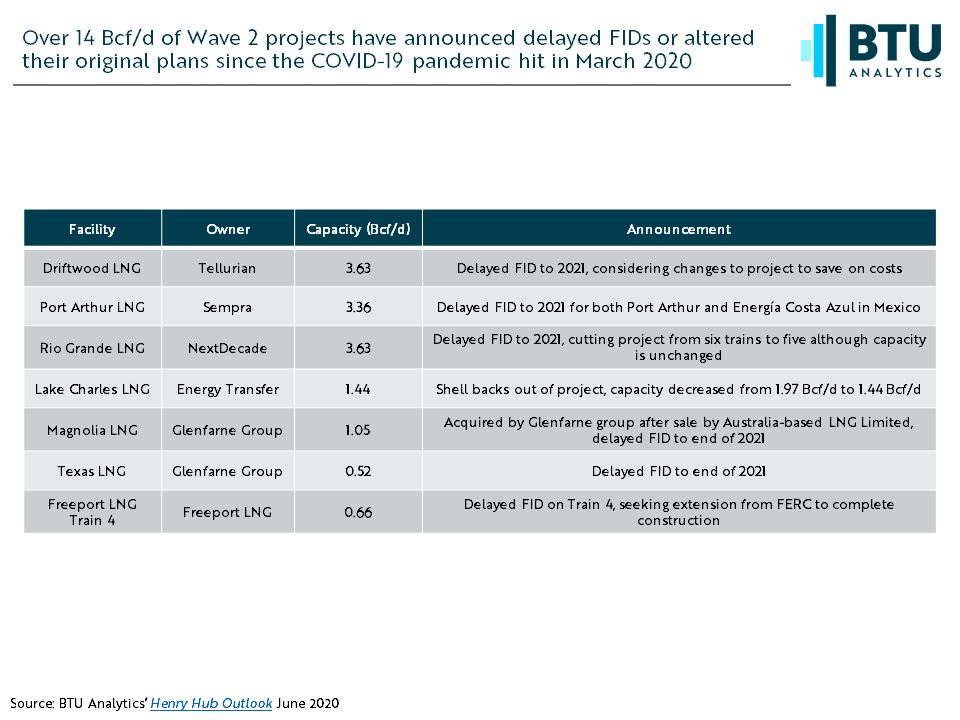Just under a year ago, BTU Analytics released Getting to the Gulf, an in-depth analysis of Wave 2 LNG facilities and the potential infrastructure bottlenecks that could hinder growth. At the time, US LNG demand had been on a steady upward trend with feedgas deliveries growing over 90% in 2019. However, the COVID-19 pandemic has disproportionately hit US LNG exports and as a result significantly altered the trajectory of US LNG forecasts. In today’s Energy Market Insight, BTU Analytics revisits Wave 2 LNG facilities’ progress, or lack thereof, that could put Wave 2 LNG in jeopardy.
Wave 2 LNG facilities were already struggling to make progress even before the pandemic hit. Cratering global LNG prices and a trade war with China left many proposed facilities unable to secure long-term offtake contracts with potential buyers. The impacts of COVID-19 on the global economy have further exacerbated those problems. Since the end of March, at least 7 Wave 2 facilities totaling over 14 Bcf/d have delayed or altered their original plans. These announcements are summarized in the table below. The three largest projects, Driftwood LNG, Rio Grande LNG, and Port Arthur LNG have all delayed FID to at least 2021. Another major facility, Lake Charles LNG, announced it would delay FID and downsize the scale of the project after Shell withdrew from the project leaving Energy Transfer the sole owner of the facility.

Despite the numerous delays and general bearish sentiment surrounding the LNG market, a few facilities have continued to make forward progress. Notably, three of the four facilities contained in BTU Analytics’ current LNG forecast have announced positive developments even with current LNG demand faltering. After reaching a positive FID late last year, Calcasieu Pass LNG has already begun installing liquefaction equipment four months ahead of schedule. Venture Global’s second facility, Plaquemines LNG, also appears to be moving ahead after receiving FERC approval to begin site clearing activities. The project is expected to reach FID later this year and enter service in 2023. Finally, Golden Pass LNG filed with FERC to increase the capacity of the facility from 2.05 Bcf/d to 2.38 Bcf/d. According to joint venture partners Qatar Petroleum and Exxon Mobil, the project remains on track to begin liquefaction from the first train in late 2024.

For the facilities that eventually make it to market, it is looking increasingly likely that many will not run at full utilization as previously thought. Prior to the drop in LNG demand earlier this year, facility utilization rates for existing US LNG facilities showed heavy usage of available capacity. In 2018 and 2019, weighted average utilization across all US facilities consistently averaged over 90%. In 1Q2020, this ticked up even higher to 100% of nameplate capacity as Sabine and Cameron ran well over nameplate capacity. Beginning in April, however, utilization began to drop, falling back to 94% before reaching 58% in June with the startup of additional trains at Freeport and Cameron.
While the outlook for US LNG demand has been grim, the forward progress made by some key facilities provides a glimmer of hope. As the global economy begins to recover, Wave 2 facilities that were previously on the cusp of making FID will look to clear the final hurdle and put US LNG back on the path to long-term growth. BTU Analytics tracks the progress of all Wave 2 facilities and their impacts on the US LNG forecast in our monthly Henry Hub Outlook report. To request a sample or learn more about the report, follow the link or hit the “Contact Us” button at the top of the page.









